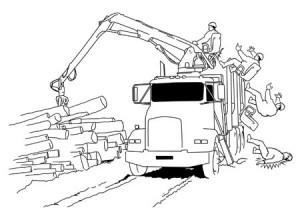BACKGROUND: On an overcast, cool winter morning in the Appalachians, a logging contractor was unloading his truck at a woodyard. He was operating the self-unloading knuckleboom on his triaxle truck.
PERSONAL CHARACTERISTICS: The 49-year-old logging contractor had approximately 20 years of experience operating a log truck. He was an extremely heavy-set individual. He was not wearing a hard hat.
UNSAFE ACT: The seat of the self-unloading knuckleboom was mounted on slides to allow it to slide back and forth. A homemade brace was welded to the back of the seat framing to prevent the seat from sliding out. The welds on the brace were either inadequate or had weakened from the repeated beating by the seat sliding back and forth. Additionally, the operator’s weight may have exceeded the seat’s load capacity.
ACCIDENT: The operator had nearly finished unloading his truck when the welds broke on the brace at the end of the slide tracks. As a result, the seat slid backwards out of the slide tracks. The operator and the seat fell backwards 13 feet to the icy, frozen ground. Another truck driver witnessed the operator fall and immediately notified woodyard personnel to call 911.
INJURY: The operator suffered a broken femur and hip and possible internal organ damage. The operator was in extreme pain but remained conscious during the 15 minutes it took paramedics to arrive on the scene. The operator was transported by ambulance to a local hospital and then transported to a regional medical center where he underwent surgery for his broken bones. The day following surgery, his organs started shutting down, and he was placed on a ventilator and dialysis machine. He spent approximately two months in intensive care and was eventually moved to a rehabilitation center. Due to additional health issues, he was in and out of the hospital several times and eventually passed away.
RECOMMENDATIONS FOR CORRECTION: Inspect the loader and seat on self-unloading trucks regularly for metal fatigue or other damage. Items to be checked should include hydraulic hoses, excess oil or grease on ladder or platform, access ladder integrity, and seat mount and bracing integrity. Understand the equipment limitations, and do not overload the weight capacity of the seat. Weld repairs should be made by a certified welder. Inadequate welds can cause further weakening of the metal and may contribute to premature failures.
When operating a loader, wear a hard hat, safety glasses, heavy-duty logging boots, heavy duty gloves, and hearing protection (if the equipment noise exceeds OSHA’s 85-decibel threshold).
 Courtesy of the Forest Resources Association: https://www.forestresources.org/
Courtesy of the Forest Resources Association: https://www.forestresources.org/
